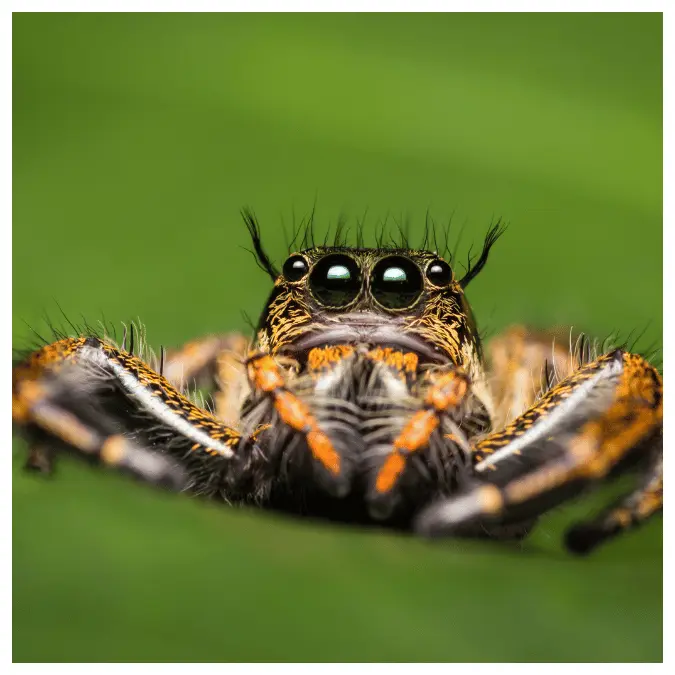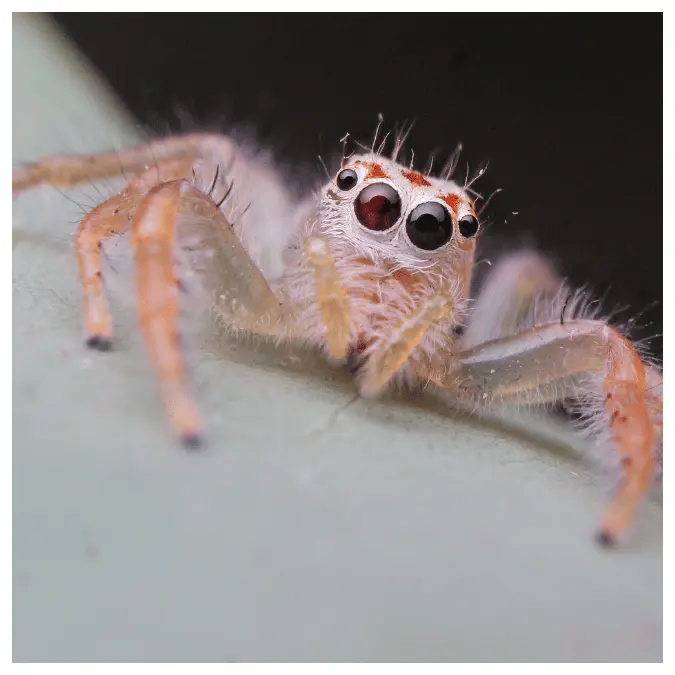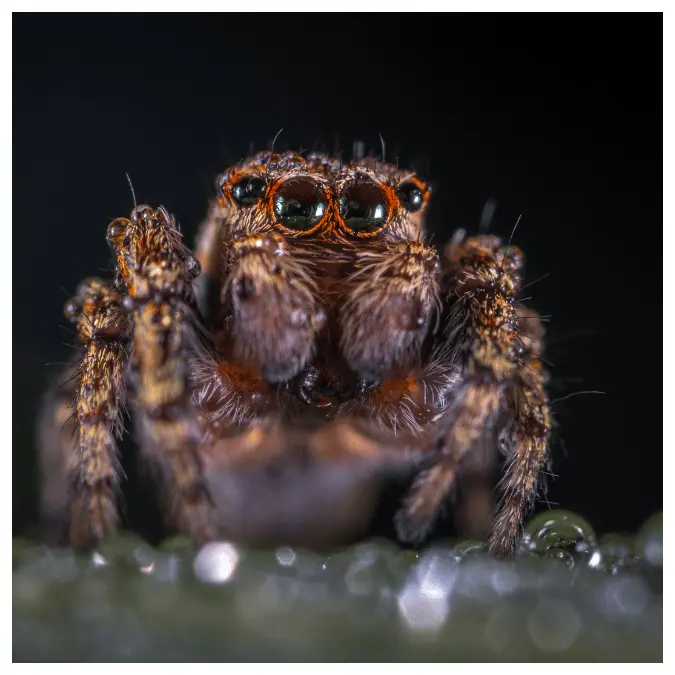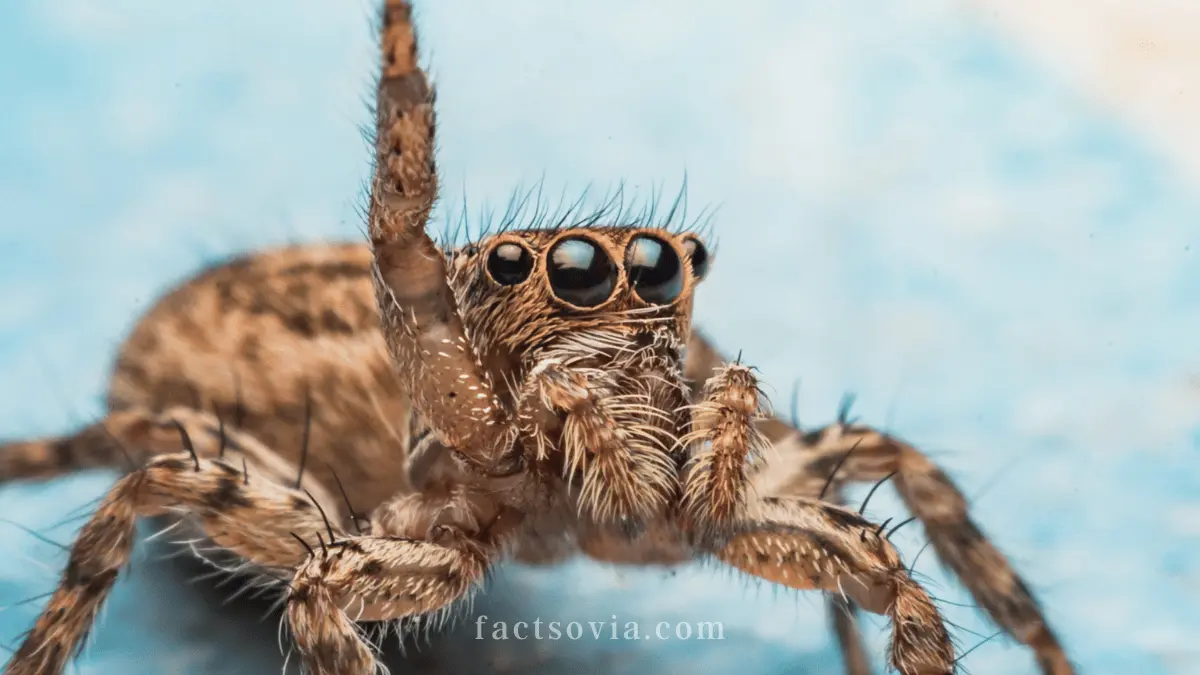We use affiliate links to run our site. When you buy through links on our site, we may earn an affiliate commission, without any added cost to you. Learn more
Hey there friends, this is Prasenjit coming to you today to share some fascinating details about an amazing little creature – the jumping spider.
These tiny acrobatic hunters have always intrigued me, and after studying them up close, I’ve learned some incredible things I can’t wait to share.
With their strong legs and big jumps, these little daredevils surprise scientists and grab people’s attention. We’ll find out how these small spiders pull off big leaps, have excellent eyesight, and take down bugs way bigger than them.
Get ready to learn amazing things about the hunters of the tiny world! This journey into the life of tiny jumpers will make you appreciate the creativity of nature.
what is a jumping spider?
Jumping spiders are a family of spiders scientifically known as Salticidae comprising over 5,000 species. They get their name from their impressive jumping and leaping abilities.
Jumping spiders are active hunters who stalk prey by stealthily moving closer before pouncing, unlike spiders that build webs. They have a square, compact body with thick fuzzy hair or iridescent scales.
Jumping spiders range from tiny to over 1 inch long and come in colors like black, brown, and bright hues of red, white, green, and blue.
Their most distinguishing features are their large front-facing eyes that give them excellent vision to locate prey.
Jumping spiders are common around homes and gardens where they find ample small insect prey.
While feared by their insect victims, jumping spiders pose no threats to humans. They are timid spiders that will try to avoid confrontation if possible.
Their unique hunting behaviors and lively personalities have made them popular educational classroom pets.
what does a jumping spider look like?

Jumping spiders are compact, hairy spiders with a rectangular-shaped body. They range in size from 1/20th inch to over 1 inch long. Jumping spiders are recognized by their suite of large, prominent eyes on the front of their head.
They have four pairs of eyes with one main pair in the center. This main pair has enhanced visual clarity and can move to track prey.
Jumping spiders come in a variety of colors like black, brown, gray, white, and sometimes vivid patterns of red, blue, green, or orange.
They are covered in furry hair that adds camouflage. Jumping spiders have strong, stocky legs specialized for jumping and clinging to surfaces. Two tarsal claws at the tips of their legs provide grip. Although they are spiders, they do not build webs and rely on stealthy hunting.
Overall, jumping spiders have a cute, inquisitive appearance, unlike other spiders.
Does spider jump?
Yes, jumping spiders can jump, leap, and pounce to hunt and navigate. Jumping spiders harbor energy in their larger hind legs and spring on prey using their muscular legs as catapults.
Of all the 40,000 species of spiders, jumping spiders stand out with their remarkable jumping talents.
how far can a jumping spider jump?
Jumping spiders are amazing jumpers and can leap distances up to 50 times their own body length. This allows the largest species, such as the zebra spider, to jump up to 2 feet horizontally.
Smaller jumping spiders may only jump a few inches. Their powerful jumps are made possible by the swift release of energy stored in a specialized muscle in their legs.
Just before takeoff, more blood is pumped into the legs, creating hydraulic pressure. Then the muscles contract suddenly like a catapult, launching the spider airborne.
Jumping spiders can change direction mid-leap to accurately land on surfaces or prey. Their exceptional jumping skills give them an advantage when hunting, navigating terrain, and evading threats.
The jumping spider’s ability to leap vast distances compared to its tiny size is unrivaled in the animal kingdom.
what does the jumping spider eat?
Jumping spiders are carnivorous and hunt small insects and arthropods. Their diet typically consists of flies, mosquitoes, crickets, ants, beetles, and other small bugs.
Unlike other spiders, jumping spiders do not build webs to catch prey. Instead, they rely on their lightning-fast reflexes and superior eyesight to stalk, pounce, and ambush their meals.
Jumping spiders will leap from place to place to stealthily approach their target before attacking. Their jumping and pouncing abilities allow them to take down prey much larger than themselves.
Jumping spiders possess venom that instantly paralyzes their prey after biting.
They do not eat plants, fruit, or other spiders. These agile hunters satisfy their appetites exclusively with various insect prey.
what to feed a jumping spider?

Jumping spiders are strictly carnivorous, eating only small insects and invertebrates. Good feeder options for pet jumping spiders include fruit flies, pinhead crickets, mealworms, waxworms, moth flies, phoenix worms, and small roaches.
Vary their diet for optimal nutrition. Feeder insects should be no bigger than 1/3 the size of the spider.
Feed juveniles flightless fruit flies daily while they grow. Adults need 2-3 feedings per week of 3-5 prey items. Gut load feeders by providing them vegetable pieces, flake fish food, or water crystals.
Coat prey in calcium powder once a week. Never give jumping spiders decomposing, wild-caught, or parasitic prey.
Providing small, nutritious live insects sustains a jumping spider’s energetic lifestyle.
how to care for a jumping spider?
Caring for a pet jumping spider requires setting up a suitable habitat and feeding it appropriately.
Start with an escape-proof tank or jar with holes for ventilation. Add 2-3 inches of substrate like coconut fiber and decor like sticks, plants, and hides.
Mist the tank daily and provide a small shallow water dish. The ideal temperature is 70-80 F.
Give the spider 3-5 live prey items like fruit flies, pinhead crickets, or mealworms 2-3 times per week. Remove uneaten prey to avoid pests.
Supplement feeder insects with calcium powder. Handle the jumping spider gently and minimally. Perform full tank cleanings monthly by rehousing the spider before wiping down the old enclosure.
Jumping spiders are relatively low-maintenance pets but do require live insects and attentive care to thrive.
how often to feed jumping spiders?
Jumping spiders should be fed 2-3 times per week once they are adults. Young spiderlings need tiny prey like flightless fruit flies provided daily until their growth slows around 2 months old.
At each feeding for adults, offer 3-5 appropriately sized live insects like pinhead crickets, mealworms, or moths.
Remove any uneaten prey within 24 hours to prevent issues. Overfeeding can lead to obesity and leave uneaten prey to die and foul their enclosure. Signs of underfeeding include lethargy, lack of web production, and a thinner abdomen.
Adjust feedings based on prey consumption and the spider’s abdomen size. Well-fed adults will have a rounded, but not distended abdomen.
Jumping spiders have fast metabolisms, so feeding multiple times weekly ensures they get adequate nutrition.
can a jumping spider bite?
Yes, jumping spiders are capable of biting if threatened or handled roughly. Their fangs and venom help them subdue struggling prey.
However, a jumper’s bite is not dangerous or harmful to humans. Their fangs are very small and only able to deliver mild venom.
A jumping spider bite may cause temporary redness, irritation, or itching on the skin surface, but the venom does not produce any lasting effects or require medical treatment.
Jumping spiders typically only bite humans in cases of mistaken identity or self-defense if grabbed or squished. Overall they are timid, non-aggressive spiders that will avoid confrontation when possible.
Proper handling is important, but jumping spiders pose minimal risk to people even with their ability to bite.
Where Does a Black Widow Live?
how to kill a jumping spider?
Jumping spiders are harmless to humans and do not need to be killed. It is recommended to avoid killing beneficial jumping spiders. If one is found indoors, gently capture it in a cup and release it outside.
Jumping spiders eat pests around homes and pose no danger. If extermination is absolutely necessary, use glue traps or aerosol spider sprays containing pyrethroids that will quickly immobilize and kill them.
Minimize their pain and suffering. Prevention involves sealing entry points and clearing clutter they hide in.
Jumping spiders deserve appreciation for their fascinating behaviors and ecological roles. They can safely be captured and observed up close before letting them return to the wild unharmed. With proper identification and understanding, jumping spiders need not be feared or killed in homes.
is a bold jumping spider poisonous?

No, bold jumping spiders are not poisonous to humans. No known jumping spiders have venom toxic enough to seriously harm people. The bold jumping spider is a common large species often spotted around homes.
They get their name from their stark black and white abdominal markings. Bold jumpers occasionally wander indoors where they may startle residents. However, they are not aggressive spiders and will not attack or bite unprovoked.
Their small fangs can deliver a harmless defensive nip if mishandled. A bite mainly causes temporary pain and irritation. The venom poses minimal medical risk to healthy adults or children.
Overall, bold jumping spiders and all jumping spiders should be safely caught and released outside if found inside. They do not seek conflict with humans and only consume other small arthropods.
How long does a jumping spider live?
The typical lifespan of most jumping spider species is 6 months to 2 years. Certain types can reach 3 years when kept in ideal conditions away from predators and the elements.
Females tend to live slightly longer than males on average. Jumping spiders that inhabit regions with cold winters and undergo periods of dormancy may also survive longer overall than tropical species.
Factors like climate, food availability, predators, and reproduction impact longevity greatly in the wild. Jumping spiders kept as pets and given proper care with the appropriate habitat, handling, and consistent feeding can live at the maximum end of their natural lifespans.
Their rapid metabolisms mean they cannot withstand long stretches without food.
Providing jumping spiders with the right environment enriches their short but action-packed lives.
Where can I buy a jumping spider?
Jumping spiders are available for purchase from select breeders and exotic pet stores, both online and in person.
Always go for a reputable dealer when buying a jumping spider and refrain from wild collections.
When sourcing a jumping spider, research breeders for quality, health, and variety of species. The prices for jumping spiders range from $10-$40 depending on age, size, and rarity of type.
Local exotic pet stores may carry basic species or can order them. Check reviews to ensure the store takes good care of its spiders. Large online sellers of invertebrates like bugs, spiders, scorpions, and centipedes may have jumping spiders seasonally.
Highly rated breeders often offer the best selection, advice, and shipping services when buying a jumping spider online.
Be aware of legal restrictions depending on your state.
Conclusion
So, I hope you’ve enjoyed this little dive into my obsession with jumping spiders. They really are some of the most incredible critters out there, and every chance I get to observe them reveals new wonders about our natural world.
I thank the Great Spirit for these quirky little creatures who brighten my path and remind me that magic is all around if you just slow down and open your eyes to see it.
Let me know if you have any other favorite tiny beings you want me to write about!
Share this with friends so they can be impressed by jumpers too. Want to find out more about tiny spiders? Check out other articles on this site.
Amazon and the Amazon logo are trademarks of Amazon.com, Inc, or its affiliates.
